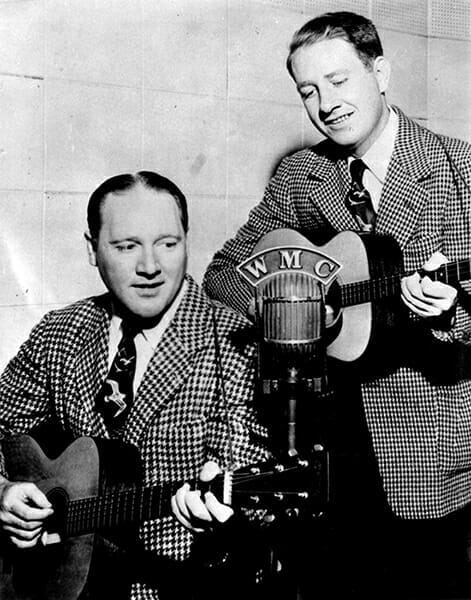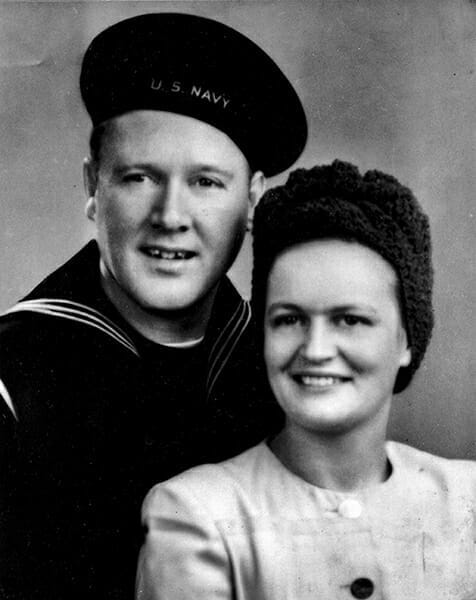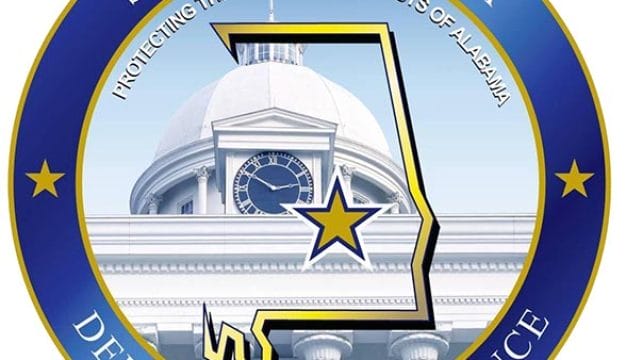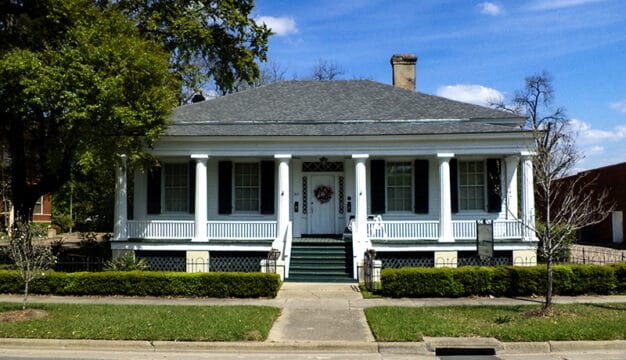Delmore Brothers
Alton (1908-1964) and Rabon (1916-1952) Delmore possessed a formidable combination of writing, singing, and musical talent that brought them fame in the 1930s and 1940s. The brothers adapted, and in some cases, created musical styles that helped define modern country music. By virtue of their proficient songwriting abilities, intricate harmonies, and complex guitar runs, the Delmore Brothers influenced their contemporaries and cast a long shadow on future generations of country performers who benefited from the professionalism, innovations, and respectability that they brought to the genre.
 Delmore Brothers
The brothers were born in Elkmont, Limestone County, just south of the Tennessee border, to Charlie and Mary Williams Delmore. Alton, the eighth of the couple’s children, was born on December 25, 1908. Rabon, the 10th child, was born on December 3, 1916. The parents were tenant farmers, but the infertile soil of northern Alabama forced Charlie to find work at a nearby cotton mill as well. As the boys grew older, they helped the family by occasionally working as hired hands on nearby farms. Alton became fascinated with music at any early age, most likely through the boys’ aunt Molly and uncle Will Williams, who taught him how to read and play music. Alton’s familiarity with traditional shape-note singing was strengthened by attending local singing schools. Like so many other youngsters in the South at that time, both boys sang at revival meetings and Sunday services. In his teens, Alton learned to play the guitar, fiddle, and mandolin. He also became fascinated with the tenor guitar, an instrument he saw played in a vaudeville show, and he eventually acquired one to give to Rabon, who up to that point had focused his musical attention on learning to play the fiddle and traditional guitar.
Delmore Brothers
The brothers were born in Elkmont, Limestone County, just south of the Tennessee border, to Charlie and Mary Williams Delmore. Alton, the eighth of the couple’s children, was born on December 25, 1908. Rabon, the 10th child, was born on December 3, 1916. The parents were tenant farmers, but the infertile soil of northern Alabama forced Charlie to find work at a nearby cotton mill as well. As the boys grew older, they helped the family by occasionally working as hired hands on nearby farms. Alton became fascinated with music at any early age, most likely through the boys’ aunt Molly and uncle Will Williams, who taught him how to read and play music. Alton’s familiarity with traditional shape-note singing was strengthened by attending local singing schools. Like so many other youngsters in the South at that time, both boys sang at revival meetings and Sunday services. In his teens, Alton learned to play the guitar, fiddle, and mandolin. He also became fascinated with the tenor guitar, an instrument he saw played in a vaudeville show, and he eventually acquired one to give to Rabon, who up to that point had focused his musical attention on learning to play the fiddle and traditional guitar.
In the mid-1920s, the brothers began singing and playing music as a duo at local community events and contests. With each event, they gained more experience and more confidence, and by 1930, Alton was soliciting radio stations and record companies for auditions. The success of country music acts like Jimmie Rogers and the Skillet Lickers indicated that one could make a living as a performer, and the Delmores welcomed an alternative to tenant farming. In 1931, Columbia Records offered them an audition and an opportunity to make a record in Atlanta. Although “Alabama Lullaby”/”Got the Kansas City Blues,” was their only record with Columbia and sold a modest 500 copies, the Delmores were encouraged enough to become full-time musicians. Throughout 1932, they played at schoolhouses and talent contests, hoping for an audition on the Grand Ole Opry, a radio show on station WSM in Nashville that was emerging as the premier country music program in the South.
 Alton and Thelma Delmore
In the spring of 1933, WSM’s Harry Stone responded favorably to Alton’s request for an audition with the Grand Ole Opry. The duo passed the audition and soon became one of the program’s most popular acts. Their success on WSM led to a recording contract with RCA, with their first single appearing on the company’s Bluebird label in late 1933. During their eight-year tenure with RCA, the Delmores wrote and recorded more than 100 songs, two of which, “Blues Stay Away From Me” and “Beautiful Brown Eyes,” became “crossover” hits, appealing to listeners of both popular music and country music. The brothers maintained a rather tumultuous relationship with the Opry throughout the 1930s, grateful for the exposure they received on the program but disgruntled by the touring restrictions imposed on them by its management. After leaving WSM in 1938, the Delmore Brothers embarked on a two-year tour of the South that began in Raleigh and ended in Birmingham. The brothers were hired there by WAPI radio, where they remained until 1942. Freed from the restrictive environment of the Grand Ole Opry, the Delmores indulged their propensity to experiment, both on the air and on the recordings they made for the Decca label, which signed them in 1940. The outbreak of World War II, with its rationing and recording limitations, eventually placed the duo’s musical ambitions on hiatus. The brothers also became involved directly in the war effort, with Alton serving in the U.S. Navy and Rabon working at the Wright Aircraft plant near Cincinnati, Ohio.
Alton and Thelma Delmore
In the spring of 1933, WSM’s Harry Stone responded favorably to Alton’s request for an audition with the Grand Ole Opry. The duo passed the audition and soon became one of the program’s most popular acts. Their success on WSM led to a recording contract with RCA, with their first single appearing on the company’s Bluebird label in late 1933. During their eight-year tenure with RCA, the Delmores wrote and recorded more than 100 songs, two of which, “Blues Stay Away From Me” and “Beautiful Brown Eyes,” became “crossover” hits, appealing to listeners of both popular music and country music. The brothers maintained a rather tumultuous relationship with the Opry throughout the 1930s, grateful for the exposure they received on the program but disgruntled by the touring restrictions imposed on them by its management. After leaving WSM in 1938, the Delmore Brothers embarked on a two-year tour of the South that began in Raleigh and ended in Birmingham. The brothers were hired there by WAPI radio, where they remained until 1942. Freed from the restrictive environment of the Grand Ole Opry, the Delmores indulged their propensity to experiment, both on the air and on the recordings they made for the Decca label, which signed them in 1940. The outbreak of World War II, with its rationing and recording limitations, eventually placed the duo’s musical ambitions on hiatus. The brothers also became involved directly in the war effort, with Alton serving in the U.S. Navy and Rabon working at the Wright Aircraft plant near Cincinnati, Ohio.
After the war, the Delmores moved to Cincinnati, where they appeared on WLW and recorded on Syd Nathan’s King label. While in Ohio, they met guitarist Merle Travis, and along with Grandpa Jones, recorded a number of gospel sides as The Brown’s Ferry Four. Exposed to a variety of rhythm and blues musicians at King Records, the Delmore Brothers incorporated electric guitar, piano, and an up-tempo “boogie” beat into many of their postwar recordings. Over the next five years, the duo performed on live broadcasts in Memphis and near Del Rio, Texas, at one of the infamous border “X” stations that blanketed the South with broadcast signals nearly twice the amount allowed in the United States. The duo also embraced honky-tonk and many of the progressive sounds of contemporary country music. With musicians like guitarist Louis Innes and harmonica player Wayne Raney, the Delmores presaged rockabilly with numerous “boogie” tunes that emphasized a heavy bass beat and humorous lyrics. Additionally, with blues-based material like “Blues Stay Away From Me,” the duo blurred the lines between blues, country, and popular music. True to their musical roots, though, the Delmores also produced several songs in the post-war years that match their pre-war recordings in terms of musical complexity and lyrical emotiveness.
In 1950, Alton suffered a heart attack, the first of a series of traumatic events that portended the final chapter in the Delmore Brothers’ saga. In 1951, the brothers’ father died. In the following year, Alton’s three-year old daughter died and Rabon was diagnosed with lung cancer. On December 4, 1952, Rabon died and was buried in Athens, Limestone County. Not long after, Alton moved to Huntsville, Madison County, where he worked in a post office, taught music, wrote short stories, and worked on his autobiography, Truth is Stranger Than Publicity. On June 9, 1964, he died of heart failure and was buried in Huntsville.
The Delmore Brothers left behind an impressive body of recordings that accurately reflect their remarkable songwriting, singing, and performing abilities. The musical interplay of Alton’s flat-top guitar and Rabon’s four-string tenor guitar, structured around complex chord arrangements, produced a haunting combination of blues, country, and jazz. Close harmonies sung softly and confidently gave evocative force to Alton’s tales of wandering and heartbroken souls seeking solace. Jaunty melodies and improvisational guitar leads buttressed the humor of character songs and comical observations on southern culture. Alabama and several other southeastern states were often the backdrop for their songs, whereas trains provided the vehicle for returning home for spiritual strength or a means of escape. Few country music acts can rival the Delmores’ recordings in terms of vivid imagery and haunting melodies.
The Delmores were inducted into the Nashville Songwriters Hall of Fame in 1971, the Alabama Music Hall of Fame in 1989, and the Country Music Hall of Fame in 2001. The Delmore Brothers remain icons in country music for their contributions as songwriters, gifted vocalists, musical innovators, and as consummate professionals.
Additional Resources
Delmore, Alton. Truth is Stranger Than Publicity. Nashville, Tenn.: Country Music Foundation Press, 1995.
Delmore Brothers, The. Classic Cuts, 1933-1941. Audio CD. London: JSP Records, 2004.
Lilly, John. “The Delmore Brothers.” Old Time Herald 3 (Fall 1992): 8-11.
Pruett, Lynn. “The Delmore Brothers.” Alabama Heritage 5 (Summer 1987): 20-29.
Wolfe, Charles K. “The Delmore Brothers on the Opry.” Bluegrass Unlimited 24 (October 1989): 16-23.



